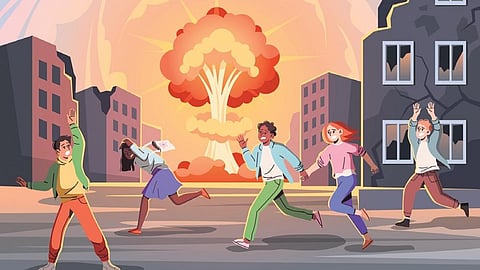

CHENNAI: Remember the history lessons from school, of wars fought, won, and lost? The dates we had to memorise for each, took away our focus and our acknowledgement of the lives maimed and scarred forever by the mindless violence, for any violence can never rest on the foundation of clear thoughts. We may be well past our history classes now, but the news of conflicts continues to menacingly threaten us from TV screens and newspapers every day. The Israel-Palestine tensions have absorbed prime space in our thoughts and conversations lately. In the midst of this chaos, does art even have a role to play?
Living in an occupied territory or a war-torn area is not only a chain on one’s physical freedom but also on one’s mind. Art then becomes one of the most sacred forms of expression to communicate one’s angst. Artists from both Israel and Palestine have been giving a voice to the reality of their truth over the years, constantly proclaiming the need for peace.
When the Umm el-Fahm Gallery opened in Israel, it was dismissed as a mere pipedream that would never last. Artist Said Abu Shakra was persistent about his dream to establish a space for Arab and Palestinian art in an impoverished Israeli town and decades later, while strife erases the last traces of harmony and co-existence, the gallery stands strong as an embodiment of hope, showcasing Palestinian art to the Israelis, building bridges and opening up dialogues.
When the Jaffa Salon of Palestinian Art was opened in Tel Aviv, it was envisioned as a temporary exhibition. But its resounding success has ensured it a permanent place, offering Israeli visitors a peep into the landscapes of Palestine, unsettling them often as they perhaps expected to see bombs and guns on canvas instead. Palestinian artist, Muhammad Rakouie, learnt to draw in an Israeli prison. He cut pillowcases to create detailed images with crayons.
The artworks ranged from political statements to a depiction of life in prison. His art was eventually smuggled out and featured in an exhibition in America. Most of Israeli artist David Reeb’s works are about the Israeli-Palestinian conflict where he juxtaposes life in Tel Aviv with the Palestinian struggle.
Given the background of antagonism, it may seem difficult for both sides to accept these artistic statements on their land, but art has always proved to be a vehicle of change that served to help understand another culture considered hostile until then. And most surprisingly, there has been a growing interest in Palestinian art among Israeli art collectors with prices on an upward surge.
This, in turn, has aided in pushing artists to reach out to art institutions in what they would have otherwise termed enemy territory.
Fear can only be overcome by confronting it. Art and culture help in dissolving misconceptions with their portrayals of the truth. With artists like Abu Shakra planning a museum with both Arab and Jewish investors in Israel with the singular goal of not just making a museum but of doing it together, there will always be hope and sanity rising from the rubble of war.